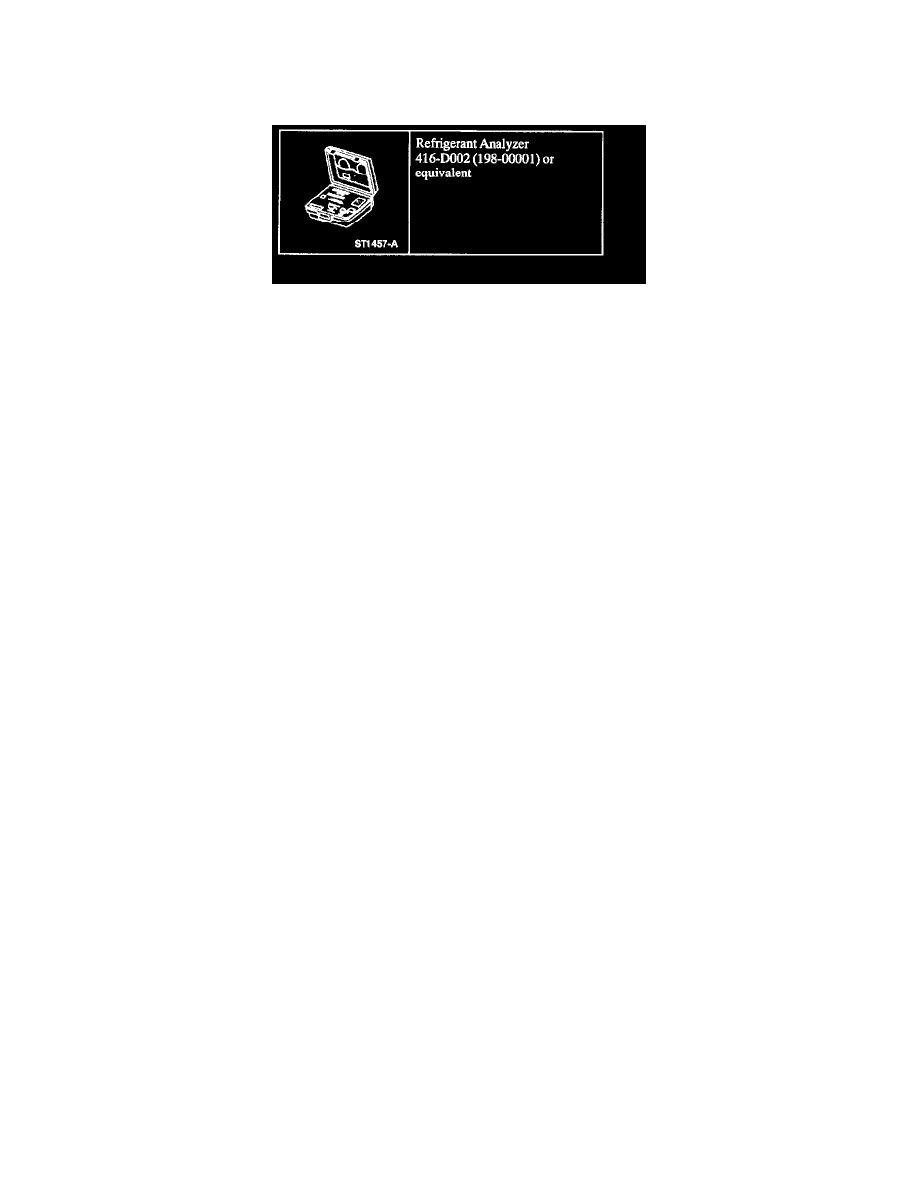Escort L4-122 2.0L SOHC (1997)

Refrigerant: Testing and Inspection
REFRIGERANT TESTING
CONTAMINATED REFRIGERANT HANDLING
Special Tool
1. The A/C Refrigerant Analyzer 198-00001 or equivalent is designed to identify vapor gas samples taken directly from automotive air conditioning
systems or refrigerant storage cylinders. Refrigerant vapor passes through the multiple sensor Non-Dispersive Infra-Red (NDIR) sensing unit. The
microprocessor calculates refrigerant type and purity percentage which is displayed on the Analyzers liquid Crystal Display (LCD).
2. The analyzer identifies the purity percentage of Rl34a, R12, R22, Flammable Hydrocarbon, and Air in the sample. If the purity percentage of the
R134a or R12 is 98% or greater by weight, a green "PASS" LED will light. If they do not meet 98% purity the red "FAIL" LED will light. Levels
of R22 and flammable HYDROCARBON's above 2% will light the "FAIL" LED. If a flammable hydrocarbon is detected above 5%, both the
"FAIL" and "HYDROCARBON" LED will light and a horn will sound, alerting the user of potential hazards.
3. The analyzer disregards any air which may be contained within the sample when calculating and displaying refrigerant purity percentage.
However, the percent of air contained in the sample will be displayed if the R-134a or R-12 is 98% or above. It is important to note that the
analyzer eliminates the effect of air when determining the concentration of gas because air is not considered a contaminate but can affect A/C
system performance. Air can be removed during the refrigerant recycling process, using UL certified recovery/recycling equipment.
Recovery of Contaminated Refrigerant
1. If contaminated refrigerant is detected, DO NOT recover the refrigerant into your R-134a recovery/recycling equipment. Take the following
actions:
a. Repeat the test to verify contaminated refrigerant is present.
b. Advise the customer of the contaminated A/C system and any additional cost to repair the system. The customer may wish to return to the
service facility performing the last A/C service.
c. Recover the contaminated refrigerant using only suitable recovery equipment designed for capturing and storing contaminated refrigerant.
This equipment must only be used to recover contaminated refrigerant to prevent the spread to other vehicles. As an alternative, contact an
A/C service facility in your area with the proper equipment to perform this service.
Repairing a Contaminated A/C System
1. Once the contaminated refrigerant is removed from the system it will be necessary to repair the system. Ford recommends that you do the
following to ensure a quality repair:
a. Determine the cause of the failure.
b. Determine which parts will need to be replaced.
c. Flush the heat exchangers to remove any oil that may be degraded due to the refrigerant contaminants.
d. Install a new suction/accumulator.
e. Properly oil match the system to ensure the correct amount of clean refrigerant oil is present in the system.
f.
Evacuate the system for 45 minutes.
g. Recharge the system; verify proper operation and leak test.
Disposal of Contaminated Refrigerant
1. Contact your current hazardous waste disposal company to determine if they are capable of disposing of the contaminated refrigerant
according to all federal, state, and local regulations.
